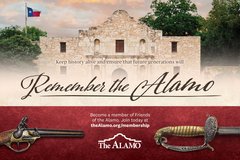The two archaeology projects planned on the grounds of the Alamo Complex started this week. The archaeology project associated with the installation of safety bollards around the perimeter of Alamo Plaza has had to redirect pedestrian traffic while the archaeologists work, but the Alamo grounds are still open to the public throughout the project.
Alamo Archaeology Update — Late 19th Century Material Like Glass Bottles and Bullet Casings Found in Long Barrack
Archaeologists from UTSA’s Center for Archaeological Research have been excavating shovel tests in areas where the bollards are to be installed to determine what kind of soils there are and if there are any important features buried underground. The two southernmost locations of the bollards appear to have road base to the depth at which the bollards are supposed to impact.

This information is helpful because it allows the archaeologists to determine which methods would be the best next plan of action. So far, very few artifacts have been encountered, and much of what has been observed has consisted of modern materials which were possibly introduced during the improvements to Alamo Plaza in the 1970s.
Archaeological excavations associated with the architectural investigations of the church and Long Barrack commenced with the opening of three test units. The units vary in size to accommodate the possibility of the need to add shoring to protect the archaeologists as they dig deeper. One unit was placed inside the southern portion of the Long Barrack.
Another was placed on the east side of the arcade in the Convento Courtyard, and the third was placed at the southwest junction of the Long Barrack east wall and the north wall of the Convento Courtyard. This unit encountered a concrete pad that may have been for a prior A/C unit. It was buried whole under approximately 10 cm of soil. Although not anticipated, the uncovering of the concrete slab will add to the knowledge of modern changes that have occurred on the site.



All three units are still in the upper layers of excavations, but are producing a collection of artifacts. The most common materials encountered are nails, glass bottles, and glass fragments. These items appear to be consistent with the time period just before the pavers and concrete sidewalk were installed. In addition to the artifacts, one interesting feature inside the Long Barrack was encountered.
The feature appears to be a post hole that may have been related to the improvements to the Long Barrack from the mid-1800s to the early 1900s. Although the feature has not been fully examined, the upper part of the post hole exhibited a large fragment of a ceramic utility pipe, which likely dates to the late 1800s to early 1900s.

Excavations will continue with the three units associated with the Long Barrack until the base of the wall foundation has been exposed. Exposure of the foundation will allow the historic architects to conduct their analysis of the condition of the structure.

